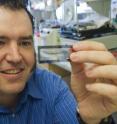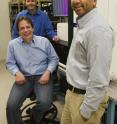Sporadic mutations identified in children with autism spectrum disorders
Scientists at the University of Washington (UW) Department of Genome Sciences have identified several sporadic or "de novo" genetic mutations in children with autism spectrum disorder. The researchers applied leading edge molecular biology techniques and massively parallel sequencing to simultaneously examine all of the protein coding portions of the genome, collectively called the exome. The research was published in advance online Sunday, May 15, in Nature Genetics.
The study was led by Dr. Brian O'Roak, senior fellow in the UW Department of Genome Sciences, and senior authors Dr. Evan Eichler, UW professor of genome sciences and a Howard Hughes Medical Institute investigator, and Dr. Jay Shendure, UW assistant professor of genome sciences.
O'Roak and colleagues analyzed the exomes of 20 individuals with autism spectrum disorder and their parents, an approach called trio-based exome sequencing. Autism spectrum disorders encompass a range of social impairments in language, communicating and interacting with others, repetitive behaviors, and engrossing fascinations. The condition can be mildly to severely disabling.
The researchers found 21 newly occurring mutations, 11 of which altered proteins. Proteins altered by genetic mutations may hold clues to the biological pathways involved in the development of the disease. The abnormal proteins or the pathways they affect could draw interest as targets in the design of preventive or treatment drugs.
O'Roak's fellowship at the UW, as well as part of the research itself, was supported by American Recovery and Reinvestment Act funding from the U.S. government. O'Roak said, "I came to the UW with the specific plan to use the latest genomic technology to study autism because it affects the lives of so many children, adults and their families."
In four of the 20 families studied, O'Roak and colleagues identified disruptive new mutations that are potentially causative for autism. In examining the clinical data on the child in each of the four families, they learned that these children were among the most severely affected of the study group, both in intellectual disability and in their autistic features.
These initial findings point to the possibility that these new sporadic disruptive genetic mutations could contribute substantially to the underlying mechanisms and severity of autism in perhaps 20 percent of the cases in which no larger family history of autism exists. In some cases, the combination of newly appearing mutations and those inherited from the parents may worsen the severity of the disorder.
"The results of the study suggest a multi-hit model as a trend, but this possibility would need to be further explored by comparing a much larger number of affected and unaffected siblings," said Eichler.
In this study, many of the discovered mutations were located in genome areas that were highly conserved during evolution. These parts of the genome likely play a fundamental role in the biology of many animals, including humans. Mutations in these regions tend to have significant repercussions.
"Consistent with the complexity of autism and its symptoms, the new mutations were identified in several different genes," lead author O'Roak said. Moreover, many of these mutated genes have already been associated with other brain disorders, including epilepsy, schizophrenia and intellectual disability -- reflecting a surprising genetic overlap.
Eichler explained that scientists are not sure what the genetic overlap means. It could point to common underlying mechanisms in the development of these neurological diseases, or different manifestations stemming from similar genetic lesions. It might also be due to many other factors, such as environmental triggers or other genes in a person's make-up that influence how and when genes operate, whether or not a disease will appear in a genetically susceptible individual, and what type of disease it will be.
How and why sporadic mutations such as these originate is as yet unknown. However researchers are uncovering clues about risk factors.
In six of the affected children in this study, the scientists were able to trace the original genes that were later mutated in the child back to the father's half the child's genome, and in one case to the mother's half.
These genetic findings further support population studies showing that autism is more common among children of older parents, especially older fathers. Eichler explained that certain genetic mutations might more likely occur during sperm formation as men age.
The scientists wrote, "The identification of de novo events along with disruptive inherited mutations underlying sporadic cases of autism spectrum disorders has the potential to fundamentally transform our understanding of the genetic basis of autism."
"Our results," Shendure noted, "show that trio-based exome sequencing is a powerful approach for identifying new candidate genes for autism spectrum disorders."
From identifying mutations, researchers hope to learn more about the biology of autism and to understand interacting genetic and environmental factors within the context of families with affected and unaffected members.
Source: University of Washington
Articles on the same topic
- New technique promises to 'lift the hood’ on autismThu, 19 May 2011, 18:36:47 UTC
- Validating preschool programs for children with autismThu, 19 May 2011, 16:36:15 UTC
Other sources
- Validating preschool programs for children with autismfrom PhysorgThu, 19 May 2011, 18:31:22 UTC
- Validating preschool programs for children with autismfrom Science DailyThu, 19 May 2011, 17:30:19 UTC
- Sporadic mutations identified in children with autism spectrum disordersfrom Science DailyMon, 16 May 2011, 22:30:31 UTC
- Researchers link spontaneous gene mutations to autismfrom PhysorgMon, 16 May 2011, 13:00:46 UTC


